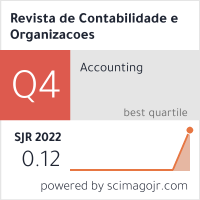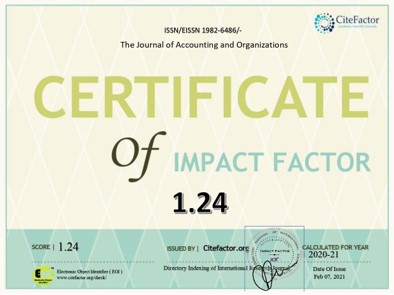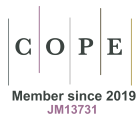Information asymmetry in the hospital budget process: Effects of agency problems on the technical efficiency and quality of provided services
DOI:
https://doi.org/10.11606/issn.1982-6486.rco.2023.210908Keywords:
Informational asymmetry, Budgeting process, Technical efficiency, Quality, HospitalAbstract
The study looks at the dichotomy between Technical Efficiency and Quality in the provision of hospital services, placing Informational Asymmetry within the Budget Process as an interactive part of this relationship in order to explain the behavior of both performance measures. The goal is therefore to analyze the effects that information asymmetries in the budget process exert on the Technical Efficiency and Quality of services performed in hospitals funded by public resources. The research strategy employed was a multiple case study, investigating two hospitals in Brazil’s South Region: one public and one nonprofit private. Three data collection techniques were used: direct observation, semi-structured interviews, and documentary analysis. As to analyzing the obtained data, content analysis using thematic topics was the adopted technique. Results indicate that Information Asymmetry in the Budget Process between the state and the hospitals, respectively Principal and Agents, when related to the budget planning stage, results in harmful effects for Technical Efficiency and beneficial ones for Quality; however, when related to a lack of financial alignment in the budget execution stage, that information asymmetry results in opposite effects, i.e., favorable for Technical Efficiency and harmful for Quality. The study’s conclusions contribute to extant discussions on the dichotomy between Technical Efficiency and Quality in services performed in hospital contexts, analyzing this phenomenon through the effects that Information Asymmetry in the Budget Process exerts on both performance measures.
Downloads
References
Afonso, G. P., Ferreira, D. C., & Figueira, J. R. (2023). A Network-DEA model to evaluate the impact of quality and access on hospital performance. Annals of Operations Research, https://doi.org/10.1007/s10479-023-05362-x
Afriyie, S. O., Kong, Y., Lartey, P. Y., Kaodui, L., Bediako, I. A., Wu, W., & Kyeremateng, P. H. (2020). Financial performance of hospitals: a critical obligation of corporate governance dimensions. International Journal of Health Planning and Management. https://doi.org/10.1002/hpm.3049
Alchian, A., & Demsetz, H. (1973). The Property Rights Paradigm. The Journal of Economic History, 33, 16-27. http://dx.doi.org/10.1017/S0022050700076403
Almeida, H. M. de, & Costa, A. V. (2018). Orçamento Público como Mecanismo de Planejamento para a Gestão. Revista de Psicologia, 13(43), 559–577. https://doi.org/10.14295/idonline.v13i43.1555
Ancarani, A., Di Mauro, C., & Giammanco, M. D. (2009). The impact of managerial and organizational aspects on hospital wards’ efficiency: Evidence from a case study. European Journal of Operational Research, 194(1), 280–293. https://doi.org/10.1016/j.ejor.2007.11.046
Arthur, F. E. (2016). Budgeting in Budget Management Centres (BMCs) in Sekondi/Takoradi Metro Health Directorate. Journal of Social Science for Policy Implications, 4(1), 63-90. https://doi.org/10.15640/jsspi.v4n1a4
Bardin, L. (1977). Análise de Conteúdo. Persona.
Ben-Ner, A., & Ren, T. (2015). Comparing Workplace Organization Design Based on Form of Ownership: Nonprofit, For-Profit, and Local Government. Nonprofit and Voluntary Sector Quarterly, 44(2), 340–359. https://doi.org/10.1177/0899764013512422
Boadway, R., Marchand, M., & Sato, M. (2004). An optimal contract approach to hospital financing. Journal of Health Economics, 23(1), 85–110. https://doi.org/10.1016/j.jhealeco.2003.08.001
Botega, L. D. A., Andrade, M. V., & Guedes, G. R. (2020). Brazilian hospitals' performance: an assessment of the unified health system (SUS). Health Care Management Science, 23(3), 443-452. https://doi.org/10.1007/s10729-020-09505-5
Brown, J. L., Evans, J. H., & Moser, D. V. (2009). Agency theory and participative budgeting experiments. Journal of Management Accounting Research, 21(1), 317–345. https://doi.org/10.2308/jmar.2009.21.1.317
Brown, J. L., Fisher, J. G., Peffer, S. A., & Sprinkle, G. B. (2017). The effect of budget framing and budget-setting process on managerial reporting. Journal of Management Accounting Research, 29(1), 31–44. https://doi.org/10.2308/jmar-51535
Chang, S. J., Hsiao, H. C., Huang, L. H., & Chang, H. (2011). Taiwan quality indicator project and hospital productivity growth. Omega, 39(1), 14–22. https://doi.org/10.1016/j.omega.2010.01.006
Chapman, C. S., & Kihn, L. A. (2009). Information system integration, enabling control and performance. Accounting, Organizations and Society, 34(2), 151–169. https://doi.org/10.1016/j.aos.2008.07.003
Chow, C. W., Cooper, J. C., & Wailer, W. S. (1988). Participative budgeting: Effects of a truth-inducing pay scheme and information asymmetry on slack and performance. The Accounting Review, 63(1), 111–122. http://www.jstor.org/stable/247682
Clement, J. P., Valdmanis, V. G., Bazzoli, G. J., Zhao, M., & Chukmaitov, A. (2008). Is more better? An analysis of hospital outcomes and efficiency with a DEA model of output congestion. Health Care Management Science, 11(1), 67–77. https://doi.org/10.1007/s10729-007-9025-8
Constituição da República Federativa do Brasil de 1988. (1998). Presidência da República. https://www.planalto.gov.br/ccivil_03/constituicao/constituicao.htm
Dismuke, C. E., & Sena, V. (2001). Is there a Trade-Off between Quality and Productivity ? The Case of Diagnostic Technologies in Portugal. Annals of Operations Research, 107, 101–116. https://doi.org/10.1023/A:1014946914816
Donabedian, A. (2005). Evaluating the quality of medical care. The Milbank Quarterly: A Multidisciplinary Journal of Population Health and Health Policy, 83(4), 691–729. https://doi.org/10.1111/j.1468-0009.2005.00397.x
Eisenhardt, K. M. (1985). Control: Organization and Economic Approaches. Management Science, 31(2), 134–149. https://doi.org/10.1287/mnsc.31.2.134
Eisenhardt, K. M. (1989). Agency Theory: An Assessment and Review. Academy of Management Review, 14(1), 57–74. https://doi.org/10.5465/amr.1989.4279003
Fama, E. (1980). Agency problems and the theory of the firm. Journal of Political Economy, 88(2), 288–307. https://doi.org/10.1086/260866
Faria, J. A.; Gomes, S. M. S.; Dias Filho, J. M.; Albuquerque, V. (2011) A assimetria da informação na elaboração do orçamento: Uma análise da produção científica nos periódicos internacionais entre 2005 e 2009. Contabilidade Vista & Revista, 22(2), 43-65. https://revistas.face.ufmg.br/index.php/contabilidadevistaerevista/article/view/936
Ferrando, A., Ivaldi, C., Buttiglieri, A., Pagano, E., Bonetto, C., Arione, R., Scaglione, L., Gelormino, E., Merletti, F., & Ciccone, G. (2005). Guidelines for preoperative assessment: Impact on clinical practice and costs. International Journal for Quality in Health Care, 17(4), 323–329. https://doi.org/10.1093/intqhc/mzi039
Ferreira, D. C., & Marques, R. C. (2019). Do quality and access to hospital services impact on their technical efficiency? Omega, 86, 218–236. https://doi.org/10.1016/j.omega.2018.07.010
Ferreira, D. C., Nunes, A. M., & Marques, R. C. (2020). Operational efficiency vs clinical safety, care appropriateness, timeliness, and access to health care: The case of Portuguese public hospitals. Journal of Productivity Analysis, 53(3), 355–375. https://doi.org/10.1007/s11123-020-00578-6
Fisher, J. G., Frederickson, J. R., & Peffer, S. A. (2002a). The effect of information asymmetry on negotiated budgets: An empirical investigation. Accounting, Organizations and Society, 27(1–2), 27–43. https://doi.org/10.1016/S0361-3682(01)00046-0
Fisher, J. G., Frederickson, J. R., & Peffer, S. A. (2000). Budgeting : An Experimental of Negotiation. The Accounting Review, 75(1), 93–114. https://doi.org/10.2308/accr.2000.75.1.93
Fisher, J. G., Maines, L. A., Peffer, S. A., & Sprinkle, G. B. (2002b). Using budgets for performance evaluation : Effects of resource allocation and horizontal information assymetry and budget proposals, budget slack, and performance. The Accounting Review, 77(4), 847–865. http://www.jstor.org/stable/3068873
Gil, A. C. (2008). Métodos e técnicas de pesquisa social (6th ed.). Atlas.
Guerra, M. (2011). Análise de Desempenho de Organizações Hospitalares. Dissertação de Mestrado, Centro de Pós-Graduação e Pesquisas em Contabilidade e Controladoria, da Faculdade de Ciências Econômicas, Universidade Federal de Minas Gerais. http://hdl.handle.net/1843/BUOS-8KZNFA
Hansen, S. C., & Van der Stede, W. A. (2004). Multiple facets of budgeting: An exploratory analysis. Management Accounting Research, 15(4), 415–439. https://doi.org/10.1016/j.mar.2004.08.001
Homauni, A., Markazi-Moghaddam, N., Mosadeghkhah, A., Noori, M., Abbasiyan, K., & Jame, S. Z. B. (2023). Budgeting in Healthcare Systems and Organizations: A Systematic Review. Iranian Journal of Public Health, 52(9), 1889-1901. https://doi.org/10.18502/ijph.v52i9.13571
Hu, H. H., Qi, Q., & Yang, C. H. (2012). Analysis of hospital technical efficiency in China: Effect of health insurance reform. China Economic Review, 23(4), 865–877. https://doi.org/10.1016/j.chieco.2012.04.008
Jensen, M. C., & Meckling, W. H. (1976). Theory of the Firm: Managerial Behavior, Agency Costs and Ownership Structure. Journal of Financial Economics, 3(4), 162–176. https://dx.doi.org/10.2139/ssrn.94043
Jing, R., Xu, T., Lai, X., Mahmoudi, E., & Fang, H. (2020). Technical efficiency of public and private hospitals in Beijing, China: A comparative study. International Journal of Environmental Research and Public Health, 17(1). https://doi.org/10.3390/ijerph17010082
Kamau, J. K., Rotich, G., & Anyango, W. (2017). Effect of budgeting process on budget performance of state corporations in Kenya: A case of Kenyatta National Hospital. International Academic Journal of Human Resource and Business Administration, 2(3), 255-281. https://www.iajournals.org/index.php/8-articles/197-iajhrba-v2-i3-255-281
Karila, A., Vakkuri, J., & Lehto, J. (2020). Budgetary bias in the Finnish public hospital system. International Journal of Public Sector Management, 33(4), 401–418. https://doi.org/10.1108/IJPSM-07-2019-0184
Kihn, L. A. (2011). How do controllers and managers interpret budget targets? Journal of Accounting & Organizational Change, 7(3), 212–236. https://doi.org/10.1108/18325911111164187
Kyj, L., & Parker, R. J. (2008). Antecedents of budget participation: Leadership style, information asymmetry, and evaluative use of budget. Abacus, 44(4), 423–442. https://doi.org/10.1111/j.1467-6281.2008.00270.x
Lai, H. pin, & Tang, M. C. (2018). Hospital efficiency under global budgeting: evidence from Taiwan. Empirical Economics, 55(3), 937–963. https://doi.org/10.1007/s00181-017-1317-3
Lambert, R. A. (2006). Agency Theory and Management Accounting. Handbooks of Management Accounting Research, 1(06), 247–268. https://doi.org/10.1016/S1751-3243(06)01008-X
Lavarda, C. E. F., & Almeida, D. M. (2013). Budget participation and informational asymmetry: a study in a multinational company. Brazilian Business Review, 10(2), 72-94. https://doi.org/10.15728/bbr.2013.10.2.4
Li, D., Su, M., Guo, X., Zhang, W., & Zhang T. (2022). The Effect of Medical Choice on Health Costs of Middle-Aged and Elderly Patients with Chronic Disease: Based on Principal-Agent Theory. International Journal of Environmental Research and Public Health, 19(13), 7570. https://doi.org/10.3390/ijerph19137570
Lin, J. R., Chen, C. Y., & Peng, T. K. (2017). Study of the relevance of the quality of care, operating efficiency and inefficient quality competition of senior care facilities. International Journal of Environmental Research and Public Health, 14(9). https://doi.org/10.3390/ijerph14091047
Maggetti, M., & Papadopoulos, Y. (2018). The Principal–Agent Framework and Independent Regulatory Agencies. Political Studies Review, 16(3), 172–183. https://doi.org/10.1177/1478929916664359
Marques, M. C. C. (2007). Aplicação dos Princípios da Governança Corporativa ao Setor Público. Revista de Administração Contemporânea, 11(2), 11–26. https://doi.org/10.1590/S1415-65552007000200002
Martins, V. A., Silva, W. V., Melo, R. A., Marchetti, R. Z., & Veiga, C. P. (2016). Teoria de agência aplicada no setor público. Espacios, 37(35). https://www.revistaespacios.com/a16v37n35/16373525.html
Melo, M. A. (2015). Governance e reforma do Estado: o paradigma agente x principal. Revista do Serviço Público, 47(1), 67–82. https://doi.org/10.21874/rsp.v47i1.704
Mitnick, B. M. (2013). Agency Problems and Political Institutions. SSRN Electronic Journal. https://doi.org/10.2139/ssrn.2338579
Mitnick, B. M. (2015). Agency Theory. Wiley Encyclopedia of Management, 1–6. https://doi.org/10.1002/9781118785317.weom020097
Mucci, D. M., Frezatti, F., & Dieng, M. (2016). As Múltiplas Funções do Orçamento Empresarial. Revista de Administração Contemporânea, 20(3), 283–304. https://doi.org/10.1590/1982-7849rac2016140121
Marques, K. C. M., Camacho, R. R., & Alcantara, C. C. V. (2015). Assessment of the methodological rigor of case studies in the field of management accounting published in journals in Brazil. Revista Contabilidade e Finanças, 26(67), 27–42. https://doi.org/10.1590/1808-057x201500280
Navarro-Espigares, J. L., & Torres, E. H. (2011). Efficiency and quality in health services: A crucial link. Service Industries Journal, 31(3), 385–403. https://doi.org/10.1080/02642060802712798
Nayar, P., & Ozcan, Y. A. (2008). Data envelopment analysis comparison of hospital efficiency and quality. Journal of Medical Systems, 32(3), 193–199. https://doi.org/10.1007/s10916-007-9122-8
Oliveira, C. B., & Filho, J. R. F. (2017). Agency problems in the public sector: The role of mediators between central administration of city hall and executive bodies. Revista de Administração Publica, 51(4), 596–615. https://doi.org/10.1590/0034-7612171397
Oliveira, D. C. (2008). Análise de Conteúdo Temático-Categorial: Uma Proposta de Sistematização. Revista de Enfermagem UERJ, 16(4), 569-576. https://pesquisa.bvsalud.org/portal/resource/pt/lil-512081
Peltokorpi, A., Matinheikki, J., Lehtinen, J., & Rajala, R. (2020). Revisiting the unholy alliance of health-care operations: payor–provider integration of occupational health services. International Journal of Operations and Production Management, 40(4), 357–387. https://doi.org/10.1108/IJOPM-04-2019-0326
Pereira, M. A., Ferreira, D. C., Figueira, J. R., & Marques, R. C. (2021). Measuring the efficiency of the Portuguese public hospitals: A value modelled network data envelopment analysis with simulation. Expert Systems with Applications, 181, 115169, https://doi.org/10.1016/j.eswa.2021.115169
Peters, D. H., Garg, A., Bloom, G., Walker, D. G., Brieger, W. R., & Hafizur Rahman, M. (2008). Poverty and access to health care in developing countries. Annals of the New York Academy of Sciences, 1136, 161–171. https://doi.org/10.1196/annals.1425.011
Przeworski, A. (1996). Nota sobre o estado e o mercado. Brazilian Journal of Political Economy, 16(3). https://doi.org/10.1590/0101-31571996-0987
Shapiro, S. P. (2005). Agency theory. Annual Review of Sociology, 31, 263–284. https://doi.org/10.1146/annurev.soc.31.041304.122159
Shastri, K., & Stout, D. (2008). Budgeting: Perspectives from the Real World. Management Accounting Quarterly, 10(1), 18–25. https://www.imanet.org/-/media/c72ba62b78e5476caa06d2cc2ddc40c0.ashx
Shields, J. F., & Shields, M. D. (1998). Antecedents of participative budgeting. Accounting, Organizations and Society, 23(1), 49–76. https://doi.org/10.1016/S0361-3682(97)00014-7
Silva, B. N. da, Costa, M. A. S., Abbas, K., & Galdamez, E. V. C. (2017). Eficiência Hospitalar das Regiões Brasileiras: Um Estudo por Meio da Análise Envoltória de Dados. Revista de Gestão em Sistemas de Saúde, 6(1), 76–91. https://doi.org/10.5585/rgss.v6i1.314
Silva, M. Z., Moretti, B. R., & Schuster, H. A. (2016). Avaliação da eficiência hospitalar por meio da análise envoltória de dados. Revista de Gestão em Sistemas de Saúde, 5(2), 100-114. http://dx.doi.org/10.5585/rgss.v5i2.248
Singaroyan, R., Seed, C. A., & Egdell, R. M. (2006). Is a target culture in health care always compatible with efficient use of resources? A cost-effectiveness analysis of an intervention to achieve thrombolysis targets. Journal of Public Health, 28(1), 31–34. https://doi.org/10.1093/pubmed/fdi072
Souza, A. A., Silva, O. F., Avelar, E. A., & Lamego, L. F. (2016). Análise de Eficiência dos Hospitais : Um Estudo com Foco em Indicadores Operacionais. Caderno de Administração, 24(2). https://periodicos.uem.br/ojs/index.php/CadAdm/article/view/32398
Souza, P. C., Gurtler Scatena, J. H., & Kehrig, R. T. (2017). Eficiência hospitalar no SUS: análise de 10 hospitais do mix público-privado do estado de Mato Grosso. Cadernos Gestão Pública e Cidadania, 22(72), 326–345. https://doi.org/10.12660/cgpc.v22n72.66242
Stake, R. E. (2005). Qualitative case studies. In Denzin, N. K., & Lincoln, Y. S. The sage handbook of qualitative research. (3rd ed). Sage Publications.
Trivelato, P. V., Soares, M. B., Rocha, W. G., & Faria, E. R. de. (2015). Avaliação da eficiência na alocação dos recursos ecônomicos financeiros no âmbito hospitalar. Rahis, 12(4), 62–79. https://doi.org/10.21450/rahis.v12i4.2725
Valdmanis, V. G., Rosko, M. D., & Mutter, R. L. (2008). Hospital quality, efficiency, and input slack differentials. Health Services Research, 43(5 P2), 1830–1848. https://doi.org/10.1111/j.1475-6773.2008.00893.x
Van Der Stede, W. A. (2000). The relationship between two consequences of budgetary controls: Budgetary slack creation and managerial short-term orientation. Accounting, Organizations and Society, 25(6), 609–622. https://doi.org/10.1016/S0361-3682(99)00058-6
Waithaka, D., Tsofa, B., Kabia, E., & Barasa, E. (2018). Describing and evaluating healthcare priority setting practices at the county level in Kenya. Health Planning and Management, 33(3), 733-750. https://doi.org/10.1002/hpm.2527
Williamson, Oliver E. (1998). Transaction cost economics: How it works; where it is headed. Economist, 146(1), 23–58. https://doi.org/10.1023/A:1003263908567
Yan, J., Lin, H. H., Zhao, D., Hu, Y., & Shao, R. (2019). China’s new policy for healthcare cost-control based on global budget: a survey of 110 clinicians in hospitals. BMC Health Services Research, 19, 84. https://doi.org/10.1186/s12913-019-3921-8
Yan, Y. H., Hsu, S., Yang, C. W., & Fang, S. C. (2010). Agency problems in hospitals participating in self-management project under global budget system in Taiwan. Health Policy, 94(2), 135–143. https://doi.org/10.1016/j.healthpol.2009.09.005
Yan, Y. H., Yang, C. W., & Fang, S. C. (2014). Agency problems of global budget system in Taiwan’s National Health Insurance. Health Policy, 116(1), 37–50. https://doi.org/10.1016/j.healthpol.2014.02.005
Yang, J., & Zeng, W. (2014). The trade-offs between efficiency and quality in the hospital production: Some evidence from Shenzhen, China. China Economic Review, 31, 166–184. https://doi.org/10.1016/j.chieco.2014.09.005
Yin, R. K. (2005). Estudo de Caso: Planejamento e Métodos. (3rd. ed.). Bookman.
Zogning, F. (2017). Agency Theory: A Critical Review. European Journal of Business and Management, 9(2), 1–8.
Downloads
Published
Issue
Section
License
Copyright (c) 2023 Vitor Hugo Garcia de Souza, Katia Abbas, Valter da Silva Faia, Marcelo Marchine Ferreira

This work is licensed under a Creative Commons Attribution-NonCommercial-NoDerivatives 4.0 International License.
The RCO adopts the Free Open Access policy, under the standard Creative Commons agreement (CC BY-NC-ND 4.0). The agreement provides that:
- Submission of text authorizes its publication and implies commitment that the same material is not being submitted to another journal. The original is considered definitive.
- Authors retain the copyright and grant the journal the right of first publication, with the work simultaneously licensed under the Creative Commons Attribution License which allows the sharing of the work with acknowledgment of authorship and initial publication in this journal.
- Authors are authorized to take additional contracts separately, for non-exclusive distribution of the version of the work published in this journal (e.g. publish in an institutional repository or as a book chapter), with necessary recognition of authorship and initial publication in this journal.
- Authors are allowed and encouraged to publish and distribute their work online (e.g. in institutional repositories or on their personal page) before or during the editorial process, as this can generate productive changes as well as increase the impact and citation of published work (See The Effect of Free Access).
- The journal does not pay copyright to the authors of the published texts.
- The journal's copyright holder, except those already agreed in the Free Open Access Agreement (CC BY-NC-ND 4.0), is the Accounting Department of the Faculty of Economics, Administration and Accounting of Ribeirão Preto of the University of São Paulo.
No submission or publication fees are charged.
Up to 4 authors per article are accepted. Exceptionally duly justified cases may be reviewed by the Executive Committee of the RCO. Exceptional cases are considered as: multi-institutional projects; manuscripts resulting from the collaboration of research groups; or involving large teams for evidence collection, construction of primary data, and comparative experiments.
It is recommended that the authorship be ordered by contribution of each of the individuals listed as authors, especially in the design and planning of the research project, in obtaining or analyzing and interpreting data, and writing. Authors must declare the actual contributions of each author, filling the letter to the editor, at the beginning of the submission, taking responsibility for the information given.
Authors are allowed to change throughout the evaluation process and prior to the publication of the manuscript. The Authors should indicate the composition and final order of authorship in the document signed by all those involved when accepted for publication. If the composition and authoring order is different than previously reported in the system, all previously listed authors should be in agreement.
In the case of identification of authorship without merit or contribution (ghost, guest or gift authorship), the RCO follows the procedure recommended by COPE.







